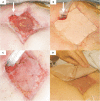The use of the Flexi-Seal Faecal Management System in laparostomy wounds involving enterocutaneous fistula
- PMID: 20501001
- PMCID: PMC5696887
- DOI: 10.1308/147870810X12659688851834
The use of the Flexi-Seal Faecal Management System in laparostomy wounds involving enterocutaneous fistula
Abstract
We present an innovative application of the Flexi-Seal Faecal Management System (FMS) for the diversion of upper and lower gastrointestinal secretions from enterocutaneous fistulae associated with complex wounds. Fistula is a common complication after the formation of a laparostomy, secondary to cases of severe intra-abdominal sepsis, acute mesenteric ischaemia, necrotising infection of the abdominal wall, or intra-abdominal hypertension. A significant mortality rate is associated with such fistula. With the successful continent diversion of gastrointestinal secretions by the Flexi-Seal FMS, abdominal wounds can be successfully skin-grafted, and wound healing expedited.
Figures

Similar articles
-
Flexi-Seal tube use for enteric fistula control in abdominal wall reconstruction--a response.J Plast Reconstr Aesthet Surg. 2011 Oct;64(10):1394. doi: 10.1016/j.bjps.2011.05.020. Epub 2011 Jun 2. J Plast Reconstr Aesthet Surg. 2011. PMID: 21640675 No abstract available.
-
Flexi-seal tube use for enteric fistula control in abdominal wall reconstruction.J Plast Reconstr Aesthet Surg. 2011 May;64(5):698-702. doi: 10.1016/j.bjps.2010.10.005. Epub 2010 Nov 19. J Plast Reconstr Aesthet Surg. 2011. PMID: 21093397 No abstract available.
-
"Fistula patch": making the treatment of enteroatmospheric fistulae in the open abdomen easier.J Trauma Acute Care Surg. 2013 Apr;74(4):1175-7. doi: 10.1097/TA.0b013e318282705e. J Trauma Acute Care Surg. 2013. PMID: 23511162
-
"Enteroatmospheric fistulae"--gastrointestinal openings in the open abdomen: a review and recent proposal of a surgical technique.Scand J Surg. 2013;102(2):61-8. doi: 10.1177/1457496913482252. Scand J Surg. 2013. PMID: 23820678 Review.
-
Open abdomen after trauma and abdominal sepsis: a strategy for management.J Am Coll Surg. 2006 Sep;203(3):390-6. doi: 10.1016/j.jamcollsurg.2006.06.001. J Am Coll Surg. 2006. PMID: 16931311 Review. No abstract available.
Cited by
-
Management of Necrotizing Fasciitis and Fecal Peritonitis following Ostomy Necrosis and Detachment by Using NPT and Flexi-Seal.Case Rep Surg. 2015;2015:231450. doi: 10.1155/2015/231450. Epub 2015 Sep 10. Case Rep Surg. 2015. PMID: 26448894 Free PMC article.
References
-
- Schecter WP, Ivatury RR, Rotondo MF, Hirshberg A. Open abdomen after trauma and abdominal sepsis: a strategy for management. J Am Coll Surg 2006; : 390–6. - PubMed
-
- Connolly PT, Teubner A, Lees NP, Anderson ID, Scott NA, Carlson GL. Outcome of reconstructive surgery for intestinal fistula in the open abdomen. Ann Surg 2008; : 440–4. - PubMed
-
- Fisher JE. The importance of reconstruction of the abdominal wall after gastrointestinal fistula closure. Am J Surg 2009; : 131–2. - PubMed
-
- Padmanabhan A, Stern M, Wishin J, Mangino M, Richey K, DeSane M. Clinical evaluation of a flexible fecal incontinence management system. Am J Crit Care 2007; : 384–93. - PubMed
Publication types
MeSH terms
LinkOut - more resources
Full Text Sources
Other Literature Sources
Miscellaneous

